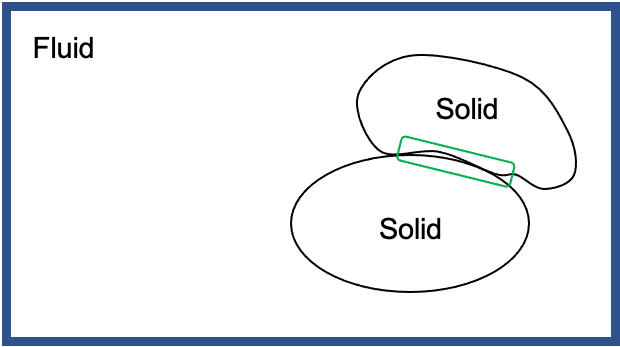Lubricated Contact Model
The interaction of contacting surfaces separated by a layer of fluid film is of great importance in various engineering and biomechanical applications. It is related to a wide field of the FSI (fluid-structure interaction) problems involving the relative motion, and possibly, the deformations of solids upon their interactions with the fluids. Many areas correspond to these problems, enhancing the range. These areas mainly vary according to space scales, time scales, operating conditions, and material properties. This broad range restricts the use of a unified FSI approach fitting for all the problems, and thus, researchers have to rely on various methods for each problem. Classically, the fluid part of the FSI problem is governed by the Navier-Stokes equation in a standard separate domain. However, lubrication theory is using essentially a reduction of the fluid equations to a two-dimensional manifold base on the small gap assumptions. Therefore, the lubricated contact problem is a particular kind of the FSI problem in which the fluid part is modeled using the Reynolds equation upon adopting the thin-film approximation. Those formulations investigating the EHL (Elastohydrodynamic lubrication) of two high-stiffness elements, such as spur gears or ball bearings, are known as hard-EHL. On the other hand, soft-EHL is considered for applications in which one or both of the lubricated bodies have a low elastic modulus, such as rubber seals or wet tires. Thereby, large elastic deformations take place despite low fluid pressure, making the problem more complicated. Another major application area for soft-EHL models are biotribological systems, with examples being synovial joints, contact-lens lubrication, eye eyelid contact, human skin contact which are topics of interest at our institute. In fact, development of the lubricated contact model at our institute is focused on the more challenging case of soft-EHL problems and, in particular, on the consistent representation of finite deformations and the (possibly nonlinear) material behavior in the solid domain.
Currently we are developing an averaged model for the lubricated contact between deformable 3D solid bodies based on a novel approach. The averaged Reynolds equation accounts implicitly for surface roughness employing spatially homogenized, effective fluid parameters. Contrary to the existing approaches, the proposed model considers the co-existence of frictional contact tractions and hydrodynamic fluid tractions on the interfaces of two contacting deformable solids, leading to having a unified framework capable of modeling the full range of lubrication regimes from boundary to full film lubrication in a continuous way with smooth transition between them.
